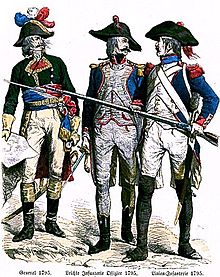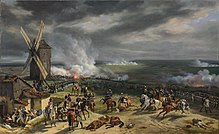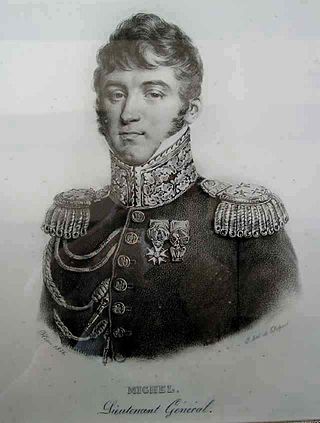
General Claude-Étienne Michel, an officer in Napoleon's army, eventually rose to second in command of the Chasseur Division of the Imperial Guard and commander of the Brigade of the Middle Guard. He may actually be the officer who uttered the words often attributed to Pierre Cambronne "La Garde meurt et ne se rend pas" "The Guard dies, and does not surrender".
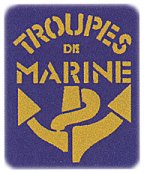
The Troupes de Marine or TDM, sometimes simply referred to as "French Marines" in English, are one of the major components of the French Army and comprise several specialties: infantry, airborne, armoured cavalry, artillery, engineering, and transmissions (signals). Characterized by their fundamental vocation for service beyond the seas, including in French overseas territories and, formerly, in French colonies, the Marines have taken part in all French military campaigns since the corps' foundation, both on home soil and in theaters of operations around the world. They are stationed in Metropolitan France, in many French overseas departments and territories, as well as in Africa.

The French Revolutionary Army was the French land force that fought the French Revolutionary Wars from 1792 to 1802. In the beginning, the French armies were characterised by their revolutionary fervour, their poor equipment and their great numbers. However, the French Revolutionary Army had become arguably the most powerful army in the world by the mid-1790s, as the French armies had become well-experienced and organized, enabling them to comfortably outfight their enemies.

The Army of Sambre and Meuse was a field army of the French Revolutionary Army. It was formed on 29 June 1794 by combining the Army of the Ardennes, the left wing of the Army of the Moselle and the right wing of the Army of the North. Its maximum paper strength was approximately 120,000.

The Battle of Arlon saw a French Republican force under the command of Amable Henri Delaage face the Austrian force led by Gottfried von Schröder. The French were victorious though they suffered higher casualties than the Austrians. The action was fought during the War of the First Coalition, part of the larger French Revolutionary Wars. Arlon is located in Belgium, a distance of 30 kilometres (19 mi) west of Luxembourg city.

The Army of the Rhine and Moselle was one of the field units of the French Revolutionary Army. It was formed on 20 April 1795 by the merger of elements of the Army of the Rhine and the Army of the Moselle.

The Army of Helvetia, or, was a command of the French Revolutionary Army. It was formed on 8 March 1798 from the remnants of the first unit to be known as the Army of the Rhine. It was officially merged into the command structure of the Army of the Danube on 29 April 1799, although it continued to operate in the Swiss theater until 1801. The Army's initial campaigning in the old Swiss Confederation resulted in severe setbacks and defeats at Feldkirch, Lusiensteig, and Zurich.
On 25 March 1799, French and Habsburg armies fought for control of the geographically strategic Hegau in present-day Baden-Württemberg. The battle has been called by various names: First Battle of Stockach, the Battle by Stockach, and, in French chronicles, the Battle of Liptingen. In the broader military context, this battle comprises a keystone in the first campaign in southwestern Germany during the Wars of the Second Coalition, part of the French Revolutionary Wars. For an explanation of the types of forces, please see Types of military forces in the Napoleonic Wars.
The 102nd Infantry Regiment was an infantry regiment of the French Revolutionary Wars and the Napoleonic Wars. Reconstituted several times in the 19th century, it took part in the Second Opium War in China, then in the First and Second World Wars, being disbanded in 1940.

The 54th Infantry Regiment is a line infantry regiment of the French Army.
Jean-Baptiste Meynier, born 22 April 1749 – died 3 December 1813, was a French soldier who served during the American Revolutionary War, the French Revolutionary Wars, and the Napoleonic Wars. Between 1792 and 1793, he rose from a captain to a general of division. During the Montenotte Campaign in 1796, he commanded a division under Napoleon Bonaparte, who had a low opinion of his military talent. In 1803 he was appointed to command the fortress of Mainz. He died there in 1813.
The 9th Light Infantry Regiment was a French army regiment. One of the most notable infantry regiments in the Napoleonic Wars, it was awarded the title "Incomparable" by Napoleon Bonaparte after their brilliant performance at the Battle of Marengo on 14 June 1800. The regiment went on to serve with distinction in the Ulm Campaign, at the Battle of Dürenstein, the Jena Campaign (1806), and the Battle of Friedland. The regiment then served in the Peninsular War taking a notable role at the Battle of Talavera 27–28 July 1809 and the Siege of Badajoz (1812). Battalions from the regiment also fought on the Wagram Campaign (1809), at the Battle of Leipzig, and Napoleon's campaigns in France (1814). During the Hundred Days the 9th Light fought at Battle of Ligny and the Battle of Wavre. The regiment was disbanded in the aftermath of the Bourbon Restoration.

Antoine Digonet commanded a French brigade during the French Revolutionary Wars and Napoleonic Wars. He joined the French Royal Army and fought in the American Revolutionary War as a foot soldier. In 1792 he was appointed officer of a volunteer battalion. He fought the Spanish in the War of the Pyrenees and was promoted to general officer. Later he was transferred to fight French royalists in the War in the Vendée. In 1800 he was assigned to the Army of the Rhine and led a brigade at Stockach, Messkirch and Biberach. Shortly after, he was transferred to Italy. In 1805 he fought under André Masséna at Caldiero. He participated in the 1806 Invasion of Naples and led his troops against the British at Maida where his brigade put up a sturdy resistance. After briefly serving in the 1809 war, he took command of Modena and died there of illness in 1811. He never married.

The Second Battle of Kehl occurred on 18 September 1796, when General Franz Petrasch's Austrian and Imperial troops stormed the French-held bridgehead over the Rhine river. The village of Kehl, which is now in the German state of Baden-Württemberg, was then part of Baden-Durlach. Across the river, Strasbourg, an Alsatian city, was a French Revolutionary stronghold. This battle was part of the Rhine Campaign of 1796, in the French Revolutionary War of the First Coalition.
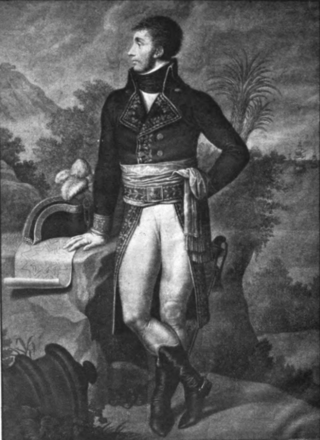
Jean Hardy commanded a French division during the French Revolutionary Wars. In 1783 he enlisted in the French Royal Army. In 1792 he joined a volunteer battalion and fought at Valmy, earning promotion to major. After leading a battalion at Wattignies and successfully holding Philippeville in 1793, he became a general of brigade. In 1794, he led troops in the Army of the Ardennes at Boussu-lez-Walcourt, Grandreng, Gosselies and Fleurus.
The Battle of Maudach occurred on 15 June 1796 between the French Revolutionary Army and the Army of the First Coalition. This was the opening action of the Rhine Campaign of 1796 on the Upper Rhine, slightly north of the town of Kehl. The Coalition, commanded by Franz Petrasch, lost 10 percent of its manpower missing, killed or wounded. It was fought at the village of Maudach, southwest of Ludwigshafen on the Rhine river opposite Mannheim. Maudach lies 10 km (6 mi) northwest of Speyer and today is a southwest suburb of Ludwigshafen; a principal town on the Rhine river in 1796.
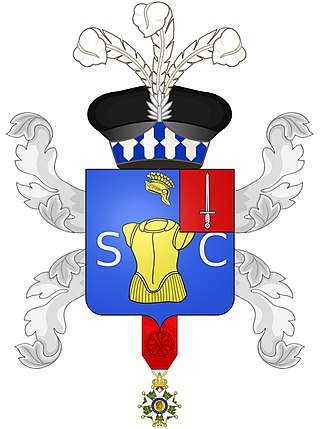
Jean-Chrysostôme Calès was a French military officer who served during the French Revolutionary Wars and the Napoleonic Wars. He was born on 27 January 1769 in Caraman (Haute-Garonne) and died on 21 April 1853 in Cessales (Haute-Garonne).

The 99th Infantry Regiment was an infantry regiment of the French Army. It was formed in 1791 by renaming the Royal Deux-Ponts Regiment and fought in the French Revolutionary Wars before being merged into another unit in 1803.
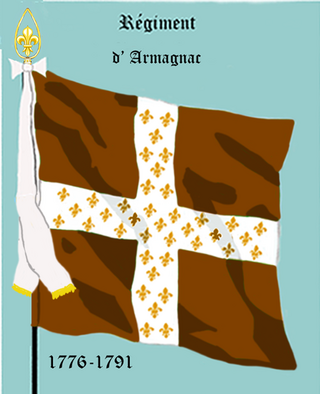
The Régiment d'Armagnac(Regiment of Armagnac) was a line infantry regiment of the French Royal Army formed in 1776, which served during the American Revolution, and later the War of the First Coalition, until it was disbanded in 1794. Just two years after formation, the regiment would serve during the Anglo-French War seeing action in both North America and the Caribbean. Following their return, a brief period of peace followed until the revolution and subsequent war, which saw the regiment's lineage discontinued.

This is the order of battle for the Battle of Tourcoing which was fought on 17–18 May 1794 between the First French Republic and the First Coalition.
